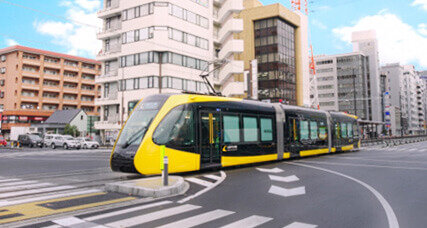No.45 In 2023
Title
Implementing a New Form of Public Transportation Through Dialogue With Local Residents
--Communities' future envisioned with the Haga Utsunomiya LRT--
Recipient
Utsunomiya City Haga Town Utsunomiya Light Rail Co., Ltd.

Reason for award
The Haga Utsunomiya Light Rail Transit (LRT; referred to by its nickname the "Lightline") began service on August 26, 2023 as the first next-generation streetcar system with entirely new lines in Japan.
The initial concept originated at the Utsunomiya Urban Development Association in 1993, when the then-governor of Tochigi Prefecture mentioned the need to improve the existing public transportation system to relieve the city of heavy commuter traffic.
Concrete planning began in 2003, when a committee comprising Tochigi Prefecture, Utsunomiya City, and transportation system experts reported that an LRT would be the best solution considering not only traffic congestion but also the aging population, the environmental impact, and the cost of the project. In preparation for its introduction, the project began by publicizing the LRT in Utsunomiya City where daily life centered around automobiles. Since LRTs were not well known in Japan at the time, leaflets were distributed to every household in the city, and over 1,000 informational meetings were held for residents, detailing everything from the city's financial situation to the significance of an LRT, to help citizens understand the project. After a thorough exchange of opinions for and against the project, including a public hearing initiated by the Transport Council of the Ministry of Land, Infrastructure, Transport and Tourism, ministerial approval to begin construction was granted in 2016. The aim was to promote the revitalization and regeneration of regional public transportation properly and steadily, and construction began in 2018. To address local residents' financial concerns, Utsunomiya City and Haga Town assumed responsibility for the maintenance and management of track facilities and rolling stock, and Utsunomiya Light Rail Co., Ltd., pledged its operating services under a public-type vertical separation system. The operators were not required to make an initial investment in maintenance because the LRT was expected to be profitable shortly after opening given the established demand for the service.
Among the system's conceptual features is the formation of a "networked compact city" aimed at sustainable core city development. This framework seeks to create a centralized hub for the housing, medical, social, commercial, and other facilities necessary for daily life, as well as for industry and tourism, through a layered network that connects these facilities with convenient public transportation such as an LRT and buses. Transit centers are located at the major LRT stations, which are the backbone of east-west travel within the network. This setup increases the convenience of transferring between modes.
Additionally, park-and-ride stations for bicycles and cars are located near the Lightline stops. Discounts are available with regionally linked IC cards, and public transit discounts can also be had. Together, these generate demand for LRT use among commuters to work and school, minimizing the impact of lane reductions due to tramway installation. Since this is a new system in an area where the public is unfamiliar with streetcars, a suitable track structure for the running spaces, with grade-separated crossings on the Lightline's track sides, was adopted to ensure conventional road safety. Furthermore, a right-turn signal system was installed to prevent traffic accidents.
Efforts are also being made to decarbonize public transport with the Lightline, a zero-carbon transport system powered by 100% locally sourced renewable energy generated via household waste incineration and household solar power, the use of electric buses, and the conversion of local transport to electric vehicles.

Additionally, the use of Transportation IC cards at each door of Lightline vehicles allows passengers to board and alight independently, ensuring the on-time regularity of the streetcar's schedule. To promote and establish the use of IC cards, they are distributed to young residents, including elementary, junior high, and high school students, and classes are held to help residents of all ages understand how to use the card to get on and off the Lightline.
To ensure that the public transport system is closely connected to and supported by local communities, all vehicles' design and interiors feature "thunder" symbolizing the area's weather and climate. Local residents have been actively involved in discussions about the name of the streetcar, the selection of names for its stops, and the selection of designs to decorate the walls at each stop and characterize each node on the line. Similarly, local businesses have been actively involved in naming rights and fundraising. Another ingenious feature is the enhanced digital infrastructure, which includes free Wi-Fi in the vehicles and at stations and digital signage at stations to encourage the circulation of visitors such as students from the digital native generation and tourists along the lines.
As previously mentioned, the Lightline was opened as a result of dialogue and collaboration with local residents, with the goal of creating a new form of public transportation for local cities in areas previously unfamiliar with streetcars given that the population is expected to decline in the coming years. We highly appreciate this leading example, which is widely applicable throughout cities in Japan facing similar problems since the solution contributes to the realization of a society with a better transportation system.
